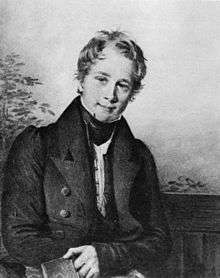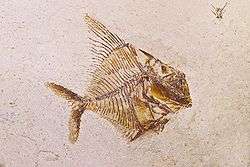François Jules Pictet de la Rive
François Jules Pictet-De la Rive (27 September 1809 – 15 March 1872) was a Swiss zoologist and palaeontologist.

Biography
He was born in Geneva. He graduated B. Sc. at Geneva in 1829, and pursued his studies for a short time at Paris, where under the influence of Georges Cuvier, de Blainville and others, he worked at natural history and comparative anatomy. On his return to Geneva in 1830 he assisted A. P. de Candolle by giving demonstrations in comparative anatomy. Five years later, when de Candolle retired, Pictet was appointed professor of zoology and comparative anatomy.[1]
In 1846 his duties were restricted to certain branches of zoology, including geology and palaeontology, and these he continued to teach until 1859, when he retired to devote his energies to the museum of natural history and to special palaeontological work. He was rector of the Academy from 1847 to 1850, and again from 1866 to 1868. He was for many years a member of the "Grand Conseil", the parliament of the Canton of Geneva, serving as its president in 1863 and 1864.

His earlier published work related chiefly to entomology, and included Recherches pour servir à l'histoire et à l'anatomie des Phryganides (1834) and two parts of Histoire naturelle, générale et particulière, des insectes névroptères (1842–1845). Feeling the want of a hand-book, he prepared his Traité élémentaire de paléontologie (4 vols. 1844-1846). In the first edition Pictet, while adopting the hypothesis of successive creations of species, admitted that some may have originated through the modification of preexisting forms. In his second edition (1853–1857) he enters further into the probable transformation of some species, and discusses the independence of certain faunas, which did not appear to have originated from the types which locally preceded them.[1]
He now directed his attention to the fossils of his native country, more especially to those of the Cretaceous and Jurassic strata, and in 1854 he commenced the publication of his great work, Matériaux pour la paléontologie suisse, ou Recueil de monographies sur les fossiles du Jura et des Alpes..., a series of quarto memoirs, of which six were published (1854–1873). In this work Pictet was aided by Eugène Renevier, Gustave Campiche, Alois Humbert, Charles Louis Perceval de Loriol, Auguste Jaccard and Philippe de La Harpe. Pictet also brought out Mélanges paléontologiques (1863–1868). He died at Geneva in 1872.[1]
A species of Malagasy snake, Elapotinus picteti, is named in his honor.[2]
References
- 1 2 3
 One or more of the preceding sentences incorporates text from a publication now in the public domain: Chisholm, Hugh, ed. (1911). "Pictet de la Rive, François Jules". Encyclopædia Britannica. 21 (11th ed.). Cambridge University Press. p. 586. Endnotes:
One or more of the preceding sentences incorporates text from a publication now in the public domain: Chisholm, Hugh, ed. (1911). "Pictet de la Rive, François Jules". Encyclopædia Britannica. 21 (11th ed.). Cambridge University Press. p. 586. Endnotes:
- Obituary by W. S. Dallas, Quart. Journ. Geol. Soc. (1873), vol. xxix.
- ↑ Beolens, Bo; Watkins, Michael; Grayson, Michael (2011). The Eponym Dictionary of Reptiles. Baltimore: Johns Hopkins University Press. xiii + 296 pp. ISBN 978-1-4214-0135-5. ("Pictet", p. 207).
External links
- (French) Pictet Family Archives
- Pictures and texts of Nouvel itinéraire des vallées autour du Mont-Blanc by François Jules Pictet de La Rive can be found in the database VIATIMAGES.